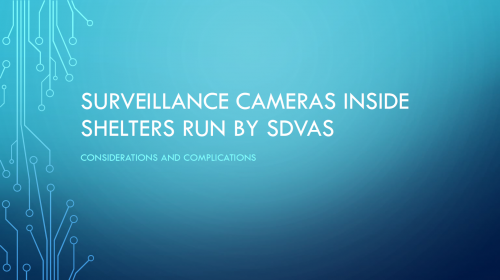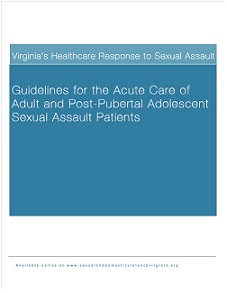Resources Library: Model Policies & Best Practices
Start a Search:
Use of Surveillance Cameras Inside Shelters Run by SDVAs

Across the U.S., there has been an increase in the use of video camera surveillance. Individuals are using these in their homes or just outside of the home to deter crime or monitor their homes while away. As with any technology, there are empowering uses and risks.
Recently, the National Network to End Domestic Violence (NNEDV), a partner and technical assistance provider for the Action Alliance, notified us that they have been receiving requests for information about the use of surveillance cameras inside shelter spaces. We have created some rough guidance for you based on
Virginia-specific laws (where applicable) and the experiences of Action Alliance staff to help you determine if this is the right path for your agency to take.
To view the recorded webinar, follow this link. For additional resources, see below.
Virginia Center on Aging: Abuse in Later Life Program
Virginia Center on Aging Abuse in Later Life Program provides professional development to those working in the fields of law enforcement, aging services, adult protective services, domestic and sexual violence, health care and more. By working collaboratively, we can put the pieces together to see and address the whole story--the whole person--the whole system and to improve the lives of victims of abuse in later life.
Click here for more information on this resource.
Virginia’s Healthcare Response to Sexual Assault:

Guidelines for the Acute Care of Adult and Post-Pubertal Adolescent Sexual Assault Patients
The document incorporates recommendations from professionals across Virginia, as well as information from current guidelines from relevant state and national resources on the management of sexual assault patients and the collection of forensic evidence. The guidelines provide a framework for the critical role of the healthcare sector in meeting the needs of sexual assault patients and the criminal justice system. They are organized around four fundamental criteria and were developed to address the healthcare response at the community, facility, and individual levels.
While these guidelines were developed specifically for healthcare professionals and facilities, the healthcare sector is just one component of a comprehensive response to sexual violence. These guidelines will also be a valuable component of statewide efforts to establish coordinated, collaborative, and compassionate responses to sexual violence in every community in Virginia. Published by Virginia Sexual and Domestic Violence Action Alliance and Virginia Chapter of the International Association of Forensic Nurses December 2009. 127 pages.
On July 1, 2013, Virginia enacted legislation that provides a procedure health care providers may use to evaluate incapacitated patients who may have been sexually assaulted (see § 54.1-2970.1 below). The legislation is intended to be used when a sexual assault examination and physical evidence recovery is prudent, but the adult patient is unable to consent and timeliness of evidence collection is crucial prior to destruction by medical interventions or bodily functions. The law outlines specific procedures and criteria that must be met in order to allow the examination and evidence recovery without the patient’s consent. In November, an addendum to the Healthcare Guidelines was released to provide guidance to healthcare professionals on the use of this new process. It is expected that the new consent process will be infrequently used, as consent for the sexual assault examination and physical evidence recovery may be obtained from next of kin, guardians, or from the patient after the patient regains the capacity to consent following temporary incapacity.
Volunteer Training Curriculum

The Volunteer Training Curriculum for Virginia’sSexual and Domestic Violence Agenciess provides 32 hours of activities designed to meet training standards for volunteers. The curriculum includes everything needed to conduct the trainings – a timed outline with learning objectives, handouts, and materials for activities.
Some of the topics addressed in the training include:
• Intimate Partner and Sexual Violence 101
• Prevention 101
• Histories of the Domestic and Sexual Violence Movements
• Crisis Intervention and Communication Basics
• Risk Assessment and Safety Planning
• Working with Children
• The Intersections of Violence and Oppression
• Trauma Stewardship
• And much, much more!
The link below provides access to the full curriculum. Look for the Session 1-8 files for all of the handouts and materials
Volunteer Training Curriculum: Session 1 Handouts and Materials

The Volunteer Training Curriculum for Virginia’sSexual and Domestic Violence Agenciess provides 32 hours of activities designed to meet training standards for volunteers. The curriculum includes everything needed to conduct the trainings – a timed outline with learning objectives, handouts, and materials for activities.
Session 1 is 3 hours and includes activities designed to inform participants about the basics of intimate partner and sexual violence.

